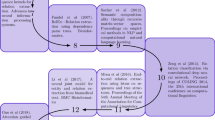Abstract
Open Information Extraction (OIE) is a challenging task of extracting relation tuples from an unstructured corpus. While several OIE algorithms have been developed in the past decade, only few employ deep learning techniques. In this paper, a novel OIE neural model that leverages Recurrent Neural Networks (RNN) using Gated Recurrent Units (GRUs) is presented. Moreover, we integrate the innovative contextual word embeddings into our OIE model, which further enhances the performance. The results demonstrate that our proposed neural OIE model outperforms the existing state-of-art on two datasets.
Access this chapter
Tax calculation will be finalised at checkout
Purchases are for personal use only
Similar content being viewed by others
References
Cho, K., et al.: Learning phrase representations using RNN encoder-decoder for statistical machine translation. arXiv preprint arXiv:1406.1078 (2014)
Graves, A., Mohamed, A., Hinton, G.: Speech recognition with deep recurrent neural networks. In: 2013 IEEE International Conference on Acoustics, Speech and Signal Processing. IEEE (2013)
Li, B., et al.: Acoustic modeling for Google Home. In: Interspeech (2017)
Chung, H., et al.: Alexa, can I trust you? Computer 50(9), 100–104 (2017)
Yin, W., et al.: Comparative study of CNN and RNN for natural language processing. arXiv preprint arXiv:1702.01923 (2017)
Sarhan, I., Spruit, M.: Uncovering algorithmic approaches in open information extraction: a literature review. In: 30th Benelux Conference on Artificial Intelligence. Springer CSAI/JADS (2018)
Gamallo, P.: An over view of open information extraction (invited talk). In: OASIcs-Open Access Series in Informatics, vol. 38. Schloss Dagstuhl Leibniz Zentrum fuer Informatik (2014)
Banko, M., Cafarella, M.J., Soderland, S., Broadhead, M., Etzioni, O.: Open information extraction from the web. In: IJCAI, vol. 7, pp. 2670–2676 (2007)
Wu, F., Weld, D.S.: Open information extraction using Wikipedia. In: Proceedings of the 48th Annual Meeting of the Association for Computational Linguistics. Association for Computational Linguistics (2010)
Fader, A., Soderland, S., Etzioni, O.: Identifying relations for open information extraction. In: Proceedings of the Conference on Empirical Methods in Natural Language Processing. Association for Computational Linguistics (2011)
Etzioni, O., Fader, A., Christensen, J., Soderland, S., Mausam, M.: Open information extraction: the second generation. In: IJCAI, vol. 11, pp. 3–10 (2011)
Del Corro, L., Gemulla, R.: ClausIE: clause-based open information extraction. In: Proceedings of the 22nd International Conference on WWW, pp. 355–366. ACM (2013)
Cui, L., Wei, F., Zhou, M.: Neural open information extraction. arXiv:1805.04270 (2018)
Hochreiter, S., Schmidhuber, J.: Long short-term memory. Neural Comput. 9(8), 1735–1780 (1997). https://doi.org/10.1162/neco.1997.9.8.1735
Stanovsky, G., et al.: Supervised open information extraction. In: Proceedings of the 2018 Conference of the North American Chapter of the Association for Computational Linguistics: Human Language Technologies, Volume 1 (Long Papers), vol. 1 (2018)
Loper, E., Bird, S.: NLTK: the natural language toolkit. arXiv preprint cs/0205028 (2002)
Peters, M.E., et al.: Deep contextualized word representations. arXiv preprint arXiv:1802.05365 (2018)
Pennington, J., Socher, R., Manning, C.: Glove: Global vectors for word representation. In: 2014 Conference on Empirical Methods in Natural Language Processing (EMNLP) (2014)
Mikolov, T., Sutskever, I., Chen, K., Corrado, G., Dean, J.: Distributed representations of words and phrases and their compositionality. In: Advances in Neural Information Processing Systems, pp. 3111–3119 (2013)
Pascanu, R., Mikolov, T., Bengio, Y.: On the difficulty of training recurrent neural networks. In: International Conference on Machine Learning (2013)
Vukotic, V., Raymond, C., Gravier, G.: A step beyond local observations with a dialog aware bidirectional GRU network for Spoken Language Understanding. In: Interspeech (2016)
Cho, K., van Merrienboer, B., Gulcehre, C., Bougares, F., Schwenk, H., Bengio, Y.: Learning phrase representations using RNN encoder-decoder for statistical machine translation. In: EMNLP (2014)
Bansal, T., Belanger, D., McCallum, A.: Ask the GRU: multi-task learning for deep text recommendations. In: Proceedings of the 10th ACM Conference on Recommender Systems. ACM (2016)
Ramshaw, L.A., Marcus, M.P.: Text chunking using transformation-based learning. In: Armstrong, S., Church, K., Isabelle, P., Manzi, S., Tzoukermann, E., Yarowsky, D. (eds.) Natural Language Processing Using Very Large Corpora. Text, Speech and Language Technology, vol. 11, pp. 157–176. Springer, Dordrecht (1999). https://doi.org/10.1007/978-94-017-2390-9_10
Chollet, F.: Keras 2015. https://github.com/fchollet/keras. Accessed 20 Mar 2019
Abadi, M., et al.: Tensorflow: a system for large-scale machine learning. In: 12th Symposium on Operating Systems Design and Implementation (OSDI 2016) (2016)
Nair, V., Hinton, G.E.: Rectified linear units improve restricted boltzmann machines. In: Proceedings of the 27th International Conference on Machine Learning (ICML-10) (2010)
Kingma, D.P., Ba, J.: Adam: a method for stochastic optimization. arXiv preprint arXiv:1412.6980 (2014)
Stanovsky, G., Dagan, I.: Creating a large benchmark for open information extraction. In: Proceedings of the 2016 Conference on EMNLP (2016)
Yang, Z., et al.: Hierarchical attention networks for document classification. In: Proceedings of the 2016 Conference of the North American Chapter of the Association for Computational Linguistics: Human Language Technologies (2016)
Author information
Authors and Affiliations
Corresponding author
Editor information
Editors and Affiliations
Rights and permissions
Copyright information
© 2019 Springer Nature Switzerland AG
About this paper
Cite this paper
Sarhan, I., Spruit, M.R. (2019). Contextualized Word Embeddings in a Neural Open Information Extraction Model. In: Métais, E., Meziane, F., Vadera, S., Sugumaran, V., Saraee, M. (eds) Natural Language Processing and Information Systems. NLDB 2019. Lecture Notes in Computer Science(), vol 11608. Springer, Cham. https://doi.org/10.1007/978-3-030-23281-8_31
Download citation
DOI: https://doi.org/10.1007/978-3-030-23281-8_31
Published:
Publisher Name: Springer, Cham
Print ISBN: 978-3-030-23280-1
Online ISBN: 978-3-030-23281-8
eBook Packages: Computer ScienceComputer Science (R0)




